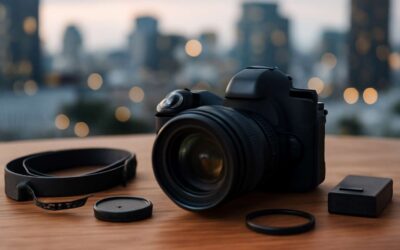There are a lot of different types of camera lenses. They vary in price, lens quality, and focal lengths, so it’s worth understanding what to look for before purchasing a new one.
Focal length: The distance between the nodal point of the optics and the image sensor in the camera body. It’s expressed in millimeters, and is important to understand because it describes the angle of view (in relation to how wide or narrow the scene is captured).
Aperture: This tells you how much of the opening in the lens let’s light in. It’s important to understand how aperture works because it’s counterintuitive and affects how sharp the image is.
f-stops: A small f-stop lets in a lot of light, while a large f-stop lets in less light. It’s important to know the difference between f-stops and apertures because they will determine the speed of your lens when working in low-light conditions, which is essential for good image quality.
Depth of field: A deep depth of field will make a lot of the scene in front of and behind the focus point appear sharply focused, while a shallow depth of field leaves a lot of the background and foreground out of focus. It’s important to understand how depth of field works because it’s useful for composing images.
Telephoto: A telephoto is used to get close-ups and to isolate your subject. It’s ideal for taking photos of wildlife, landscapes, and even sports. It’s also often a good option for portraits, as it allows you to use more natural lighting and give your subject more space.
Wide-angle: A wide-angle is a good choice for capturing the whole subject, like buildings or groups of people. They can also be used for a more interesting portrait, but be careful not to distort the face too unflatteringly by shooting too close.
They have a wide maximum aperture, which means they’re great for indoor shooting without a flash and are a good choice for full-frame cameras. They’re also fast, so you can take advantage of available light and get a better-quality image when working in low-light.
A lens with a wide maximum aperture is usually more expensive than one with a smaller maximum aperture, but it’s worth paying extra to have a faster lens that you can use in low-light.
There are many things to consider when choosing a lens, but the most important is to think about your type of photography and what you’re looking to achieve. Knowing what you want from a lens will help you choose the best one for your needs, and set you on the right path to becoming a much-improved photographer!
If you’re just starting out, it’s a good idea to start with a prime lens. These lenses have minimal distortion, are flattering to your subject and have a relatively large maximum aperture.
Ideally, you should aim for a focal length in the 23-35mm range for APS-C and 17-35mm for full-frame bodies. These will typically be f1.8-f1.8 to give shallow depth of field and be fast enough for a good image in low-light situations, letting you shoot in a variety of settings without needing a flash.


0 Comments